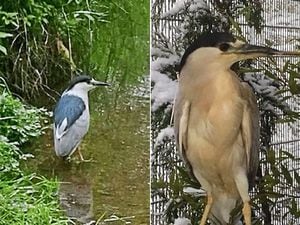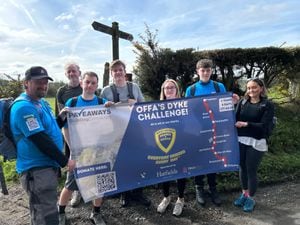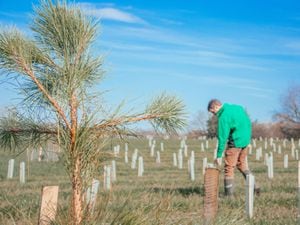Feather in Shropshire's cap as DNA tests show Noddy the heron is a rare visitor indeed
He's a character loved by those who have come across him in Shropshire – and now DNA testing has proved that Noddy the heron is one special bird.

Wildlife experts have carried out tests on the bird, who unexpectedly chose to make Shrewsbury his home.
Noddy was taken in by Shropshire's Cuan Wildlife Rescue in November after living in Shrewsbury's Dingle for about seven months.
People travelled from all over to see the heron, but a member of the public raised concerns about his health as winter fell and fish stocks plummeted.
He's since been recovering at the centre in Much Wenlock where he has put on weight and now staff are deciding his future.
Fran Hill, manager at Cuan Wildlife Rescue, said they'd ordered a DNA test for Noddy to better understand his needs and the results confirmed he is a rare American black-crowned night heron.
Although fairly ubiquitous in some parts of the world, the black-crowned heron is a very unfamiliar sight in the United Kingdom. A pair of adults were seen with two recently fledged juveniles in Somerset in 2017, which is the first proven breeding record of wild black-crowned night herons in the country.
Fran said: "Noddy was rescued in November from the Dingle when it was noticed he had lost a lot of weight. On arrival at Cuan, I examined him and found him to be very emaciated.
"After slow, gentle feeding he recovered quickly. I don’t think he's enjoyed the cold weather but he’s been eating plenty to compensate. He’s in very good health with a couple of extra ounces to keep him warm."
Night herons usually migrate to warmer countries in August and experts believe Noddy was likely to be heading to either Spain, France or Africa – but decided on Shrewsbury.
It is thought he might have been blown off course during his travels.
Noddy was first spotted in the Dingle in April, but had also been seen previously at Venus Pool at Cound.
Pictures of Noddy were shared on social media and people started making special trips to see if they could spot him sitting at the Dingle.
Fran said the bird would be assessed in the coming weeks before a decision is made on whether to release him back into the wild or not.
In the meantime he will continue to be given the VIP treatment at Cuan Wildlife Rescue.
Be a twitcher for RSPB’s Big Garden Birdwatch
Half a million people will take to their gardens this weekend to provide a nationwide audit of British birds.
The RSPB’s Big Garden Birdwatch aims to create an annual snapshot of how UK birds are doing. Now in its 39th year, the Birdwatch is a chance for people of all ages to count the number of birds that visit their garden to help the RSPB build up a picture of how our feathered friends are doing at this time of year.
There will be a number of organised events across Shropshire – or people can simply dig out a piece of pen and paper and get counting themselves.
Severn Valley Country Park in Alveley is among the sites where people can assemble for a supervised bird count. Its volunteers will be on hand between noon and 3pm on Sunday to help identify feathered visitors as well as show visitors the best way to record. There will also be the chance to make bird feeders for a £3 charge.
Last year more than 8.5 million birds were spotted visiting our gardens, with house sparrow topping the list along with some other familiar species like robin, blackbird and starling in the top 10.
In Shropshire, the top garden visitor last year was the house sparrow, followed by blackbird and blue tit. This year the RSPB wants to know how these figures have changed following a positive year for some of our resident British birds, such as greenfinch, chaffinch, blue tit, great tit and long-tailed tit.
People are being asked to take an hour out of their weekend and jot down the birds they see in their garden and add their results to the RSPB count.
Daniel Hayhow, RSPB conservation scientist, said:“It’s really as simple as spending an hour looking out the window.”
Visit rspb.org.uk/birdwatch for more details and see Saturday’s Shropshire Star for your pull-out-and-keep garden birds guide.





